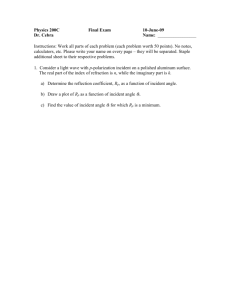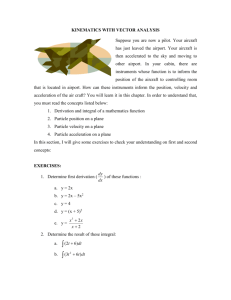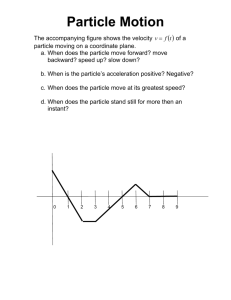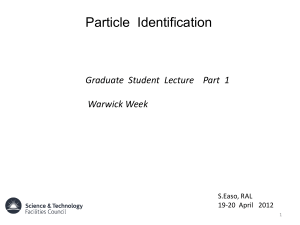200C-FE-S06 - Nuclear Physics Group
advertisement
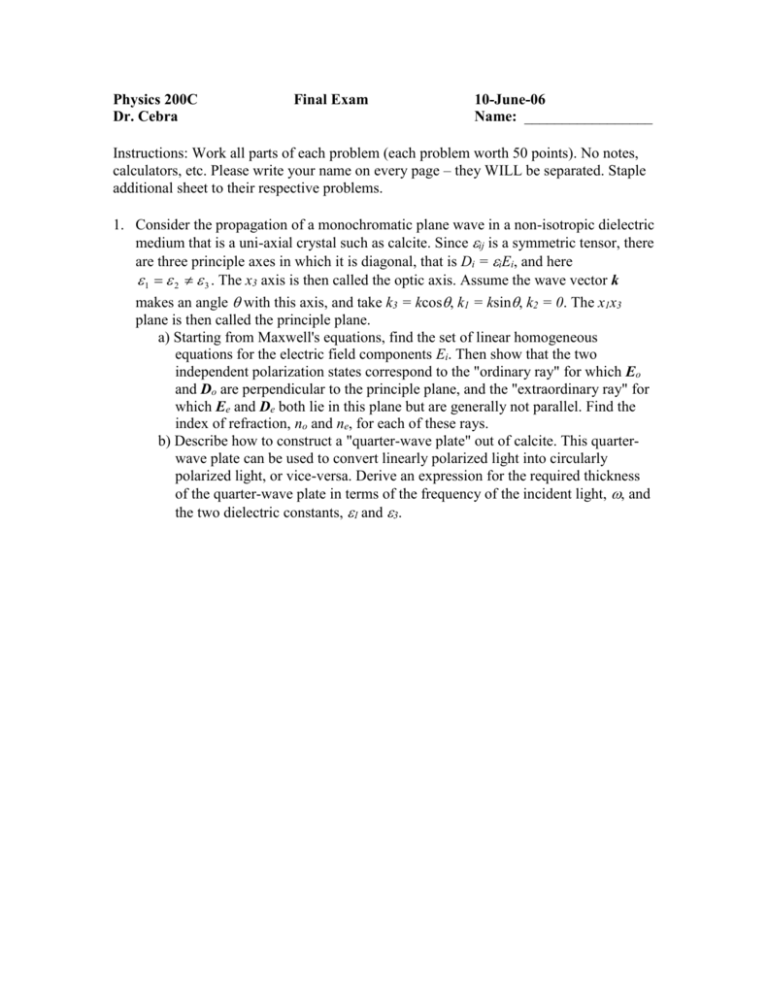
Physics 200C Dr. Cebra Final Exam 10-June-06 Name: _________________ Instructions: Work all parts of each problem (each problem worth 50 points). No notes, calculators, etc. Please write your name on every page – they WILL be separated. Staple additional sheet to their respective problems. 1. Consider the propagation of a monochromatic plane wave in a non-isotropic dielectric medium that is a uni-axial crystal such as calcite. Since ij is a symmetric tensor, there are three principle axes in which it is diagonal, that is Di = iEi, and here 1 2 3 . The x3 axis is then called the optic axis. Assume the wave vector k makes an angle with this axis, and take k3 = kcos, k1 = ksin, k2 = 0. The x1x3 plane is then called the principle plane. a) Starting from Maxwell's equations, find the set of linear homogeneous equations for the electric field components Ei. Then show that the two independent polarization states correspond to the "ordinary ray" for which Eo and Do are perpendicular to the principle plane, and the "extraordinary ray" for which Ee and De both lie in this plane but are generally not parallel. Find the index of refraction, no and ne, for each of these rays. b) Describe how to construct a "quarter-wave plate" out of calcite. This quarterwave plate can be used to convert linearly polarized light into circularly polarized light, or vice-versa. Derive an expression for the required thickness of the quarter-wave plate in terms of the frequency of the incident light, , and the two dielectric constants, 1 and 3. Phys 200C Name: _________________ 2. A choke is constructed from mild steel in the form of a toroid with a cross sectional area of A = 2 cm2 and a mean circumference of C = 50 cm. The toroid is wrapped with N = 200 turns of copper wire. A diagram of the magnetic induction for mild steel is given below. a. Estimate (roughly) how much energy is required to increase the current in the wire from zero to I = 1 A. Sketch a magnetization diagram to illustrate how to make this estimate. b. Estimate (roughly) how much energy is required to increase the current from I = 1 A to I = 2 A. c. Qualitatively sketch the magnetization curve that describes how the magnetic induction behaves as the current is reduced from I = 2 A to I = 0. Indicate on the sketch the energy recovered from the choke during this process. What has become of the rest of the energy? Phys 200C Name: _________________ 3. Consider a linearly polarized, monochromatic plane wave which is incident upon an electron. The electric field of the plane wave is given by: E (r , t ) E0 e i ( k r t ) eˆ a) Assuming that the electron is a free electron, and assuming the non-relativistic limit, determine first the acceleration of the electron and then the time-average power dP d radiated per unit solid angle (you can use the Larmor formula, because this is non-relativistic). b) The differential Thomson scattering cross-section is outgoing power per unit solid angle divided by the time-averaged pointing vector. What is the total cross-section () for Thomson scattering? c) In Rayleigh scattering we consider a harmonically bound electron such that: e x 0 x 02 x Exˆ me What is the total scattering cross-section ) for Rayleigh scattering? Phys 200C Name: _________________ 4. Cherenkov radiation is often considered to be like an optical shock wave. A charged particle traveling faster than the speed of light in a given medium will radiate light in a narrow cone. A Ring Imaging Cherenkov detector uses a radiator, of thickness d, with a high index of refraction n to cause relativistic charged particles to produce Cherenkov radiation. The Cherenkov light is imaged as a circle on a 2D imaging optical sensor which is placed a distance L behind the radiator. By combining a measurement of the charged particle’s momentum with the measurement of the Cherenkov ring one can determine the mass of an energetic charged particle. a. Determine the radius of the Cherenkov ring for a particle with momentum p and mass m incident normal to the radiator. b. Consider two species of particles with masses m1 < m2. For what values of p will one observe Cherenkov radiation from only the lighter mass particle. c. Up to what maximum value of momentum can one resolve the mass of the particle (assume the difference in ring radius must be larger than the width of the rings in order to distinguish the mass). Radiator Screen L d Incident Particle Cherenkov light Phys 200C Name: _________________ 5. A magnetic monopole with magnetic charge qm passes through matter and losses energy by collisions with electrons, just as does a particle with electric charge zqe. For the charged particle the determination of the energy loss includes the following steps: zq e E v dW ds v 2 2 z q k 02 v 2 1 dW 2 e 2 d Im ln( 1 ) ds 4 v o 2 ( ) z 2 q e2 dW ko v ln d Im ds 2 2 o2 v 2 0 mv 2 n z 2q4 dW e 2 e 2 ln ds 4o mv a) Show that the energy loss per unit distance for a monopole is given approximately by: 2 2 mv 2 q m2 qe2 dW ne ln 402 mc 2 ds monopole b) Sketch the dW/ds curve for a monopole and for a charged particle of similar mass. Discuss the similarities and the differences. cq q n c) With the Dirac quantization condition 0 e m determining the 4 2 magnetic charge, what z value is necessary for an ordinary charged particle in order that it lose energy at relativistic speeds at the same rate as a monopole? [Hint, recall that the fine structure constant qe2 / 4o c ]
